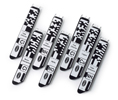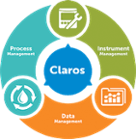|
Chlorine What is Chlorine? Chlorine is a chemical element with atomic number of 17 and molecular mass of 35.5. Naturally occurring, it is
MORE DETAILS
|
2021-04 |
|
New CL17sc Chlorine Analyzer The Next Standard in Colorimetric Chlorine Analysis View Product Page Get a Quote! Why CL17sc? Built on a legacy of reliability in online chlorine analysis, the advanced design of the CL17sc reduces routine maintenance touch time and
MORE DETAILS
|
2023-05 |
|
Chloramination Is Chloramination right for you? Chloramination disinfects drinking water by adding chlorine and ammonia to achieve a residual of monochloramine. Chloramination is favored for disinfection when there is a need to reduce the risk of disinfection byproducts (DBPs
MORE DETAILS
|
2023-03 |
|
Demand) Chloramine Chlorine Chlorine Dioxide COD (Chemical Oxygen
MORE DETAILS
|
2020-11 |
|
also indicate a distribution system failure or security issue. Find the right testing solution Free Chlorine Some utilities are required to maintain and report certain levels of free chlorine residual for systems using free chlorine for disinfection. Use the indophenol method 10241 for waters that have potential interference due to metals and
MORE DETAILS
|
2023-03 |
|
parameters and methods involved when monitoring blended source waters below. Free Chlorine Monitor for free chlorine when one of the blended source waters is a free chlorine treated water. The free chlorine value is used when the treated water is to be blended with a surface
MORE DETAILS
|
2020-12 |
|
choices to economically and sufficiently inactivate harmful microbes, remove dissolved metals and total organic carbon (TOC), minimize DBP formation, and optimize treatment processes. Chlorine is commonly used in the preoxidation phase if the source water is minimally contaminated with
MORE DETAILS
|
2023-03 |
|
compounds that, while not harmful for human consumption, can provide treatment challenges to some systems, (especially those using chlorine for the first time), e.g. Nitrate, Iron and Manganese. With
MORE DETAILS
|
2022-06 |
|
be monitored. The ammonia concentration value is used to help define the chlorine to nitrogen ratio if the treatment facility uses a chloramination process. If ammonia-containing source water is used in a free
MORE DETAILS
|
2020-12 |
|
-stream capabilities (up to 8 channels), and multiple parameter options – including total or dissolved metals. Be confident in the accuracy of your analysis, with automatic calibration and validation – or choose
MORE DETAILS
|
2023-03 |
|
fouling at one desalination plant in the Netherlands represents approximately 24% of total plant operating expenses. The bulk of that expense is incurred by early replacement of membranes. 1 How Do RO
MORE DETAILS
|
2024-04 |
|
multiple oxidants include reducing taste and odor problems and facilitating the removal of dissolved metals. Learn more about Ozone, chlorine dioxide and UV disinfection below. Ozone (O 3 ) What is Ozone
MORE DETAILS
|
2020-12 |
|
Interactive Virtual Power Plant Silica Dissolved Oxygen Sodium Chlorine pH Photometry Service Lower Maintenance, Less Downtime. The HACH 5500 sc online silica analyser for identification
MORE DETAILS
|
2020-05 |
|
to Gas Scrubber Water Analysis pH Conductivity PAH/Oil in Water Turbidity Free Chlorine, Total Chlorine Alkalinity Suspended Solids, TDS How to Measure: Process: SC1000 Controller PAH500 Oil in Water
MORE DETAILS
|
2022-06 |
|
monitored in source water. During the chloramination disinfection process, ammonia is combined with chlorine to treat drinking water and maintain a longer-lasting residual in distribution systems. Sometimes ammonia is used for pH control, such as in the pharmaceutical industry
MORE DETAILS
|
2021-04 |





